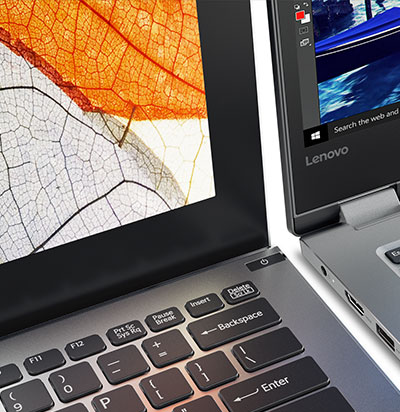
95% efficiency improvements in reporting
More targeted e-commerce strategy
From 100 reports to strategic dashboards in HR
Lenovo India is a part of the global technology company with over 55,000 employees across the world and customers in 160+ countries. With Tableau, Lenovo’s Analytics BI & Visualization team created a flexible sales dashboard that departments can adapt for ad-hoc analyses, leading to a 95% improvement in efficiency across 28 countries. The e-commerce teams analyze customer engagement metrics to craft a better online experience—leading to better brand perception and increased revenue. Human resources consolidated 100+ static reports into a set of strategic dashboards, encouraging a data-driven approach to reach team milestones. With approximately 3,000 active Tableau users in 15 business units and more than 10,000+ users accessing Tableau dashboards, Santhosh Nair, Head of Analytics BI & Visualization explains how “real-time decision-making is empowering stakeholders to drive business decisions faster.”
We can actually use that valuable time for delivering insights back into the business, which will help decision makers make decisions and take actions that will ultimately benefit the company.
95% efficiency improvements across 28 countries
Before, Lenovo worked off of one single sales report in Excel, delivered to 28 different countries. When divisions and regions wanted to adapt the report, it required engagement from eight to ten people and led to an overwhelming queue of tasks for the analytics team.
When Santhosh Nair, Head of Analytics BI & Visualization adopted Tableau as Lenovo’s analytics solution, the team saw enormous efficiency improvements.
“It used to take us maybe six to seven hours to create one single weekly report. So seven multiplied by 30 reports,” says Santhosh. “With Tableau, we gained efficiencies by 95%. People are spending a lot more time doing their true job rather than just churning out reports.”
“As soon as we got our data practices in order, we deliver that data on a daily basis or even an hourly basis,” says Marc Gallman, Senior Manager of Big Data Architecture.
The improvements don’t stop at 95%. Marc plans to keep increasing performance on the data side: “Our goal within Tableau, for any click in the dashboard, we’re trying to hit a 5 second or less performance.”



With Tableau, we gained efficiencies by 95%. People are spending a lot more time doing their true job rather than just churning out reports.
“We can actually use that valuable time for delivering insights back into the business, which will help decision makers make decisions and take actions that will ultimately benefit the company,” shares Santhosh.
The team can easily pull data from sources like Amazon Web Services and Hortonworks Hadoop Hive. “The engines are running faster so the dashboards or insights that we can deliver can be faster and more efficient.”
With Tableau, divisions can now take the comprehensive report and customize it to their needs—leading to less ad-hoc requests and more tailored dashboard solutions. This report is now updated with current data up to three times per day instead of once a week.
“We moved into one single consolidated report with a lot of interactivity,” says Santhosh. “People can actually look at those dashboards on their own, ask different business questions, get those answers up front and take decisions faster.”
10,000+ Tableau users brings a “fundamental change to the DNA of the organization”
User adoption continues to grow across Lenovo as senior executives understand the value of visual analytics. Lenovo started with an 8-core instance of Tableau Server and quickly scaled to a 16-core to accommodate user growth. Today, more than 10,000+ users access Tableau dashboards.
“We started off with a very narrow business use case and then it quickly spread. Everyone wants to talk about big data analytics but Tableau simplifies it,” shares Ashish Braganza, Director of Global Business Intelligence.
“When we first started with Tableau, we were just thinking about dashboarding and reporting. We never thought Tableau would fundamentally change the DNA of the organization,” says Ashish.
As adoption spreads, Ashish explains how the culture at Lenovo has shifted to take a more data-centric approach to challenges.
“It’s not just about a solution or a technology, it’s about how the culture towards data has changed.”
Governed self-service analytics at scale
To govern Lenovo’s data amidst this collaboration, the team integrated single sign-on with Tableau Server for a better employee experience. Tableau Server manages user access to Tableau resources based on the site roles stored in the local identity store. This helps Lenovo support self-service analytics at scale.
Josh Fitzhugh, Senior Manager of Testing & Personalization on the Customer Experience Analytics Team explains, “Tableau has facilitated and helped the team figure out a way to take all these giant amounts of collective data and provide a delivery mechanism that works for everybody at scale.”
“I’m an eternal skeptic and Tableau blew me away as to how fast it spread through our organization,” says Ashish.
When we first started with Tableau, we were just thinking about dashboarding and reporting. We never thought Tableau would fundamentally change the DNA of the organization. It’s not just about a solution or a technology, it’s about how the culture towards data has changed.
Targeted e-commerce strategy increases revenue
In a competitive e-commerce landscape, Lenovo needs to stay agile. “If we don't adapt then we will be lag behind and we will not be able to move the needle as fast as possible,” shares Santhosh.
To support this fast pace, Lenovo’s analytics team pulls data from their unified customer intelligence platform (LUCI Sky) into Tableau to analyze the customer experience on their e-commerce site. Tableau dashboards show how customers interact with content at each stage of the customer journey, helping Lenovo teams more effectively target customers and ultimately, sell more product.
Santhosh explains, “Tableau helps us map out the engagement journey, starting from exploration to the post-purchase scenario at different stages. This is being used by the organisation including the top-level executives to take decisions on a daily basis.”
In a recent article with Analytics India Magazine, Santhosh shared how Tableau helps Lenovo teams consolidate data sources to see the full scope of the customer experience.
“We have created one unique dashboard by integrating 30 different data sources,” says Santhosh. “All these data sources talk about customer feedback, which can be from social media, retailer websites, or surveys. We go through all of this data and run natural language processing to understand the themes or customers’ sentiment about Lenovo products.”
“Real-time decision-making is empowering stakeholders to drive business decisions faster, which will of course result in increased key success metrics like sales and revenue.”
From 100+ reports to strategic HR dashboards
The analytics team has enabled several divisions within Lenovo. One of them is their Human Resources department.
Before Tableau, the Human Resources team churned around 100+ reports globally across talent acquisition, compensation, sales compensation, attrition, and headcount management. This led to a long reporting cycle, making it difficult for HR leaders to make data-driven decisions.
Within just three months of using Tableau, Lenovo’s Human Resources organization created a series of strategic insights-based dashboards, helping them reach major milestones within the division.